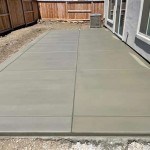```html
Installing a Sliding Patio Door: A Comprehensive Guide
Installing a sliding patio door can significantly enhance a home's aesthetics and functionality, providing easy access to outdoor spaces and increased natural light. While professional installation is always an option, homeowners with moderate DIY skills can successfully complete the project themselves with careful planning, the right tools, and a thorough understanding of the installation process. This guide provides a detailed overview of the steps involved in installing a sliding patio door.
Preparation is Key: Gathering Materials and Assessing the Opening
Before commencing any installation work, proper preparation is crucial. This involves gathering all necessary materials and thoroughly assessing the existing opening. Neglecting this stage can lead to delays, improper installation, and potential structural issues. The first step is to carefully measure the opening where the sliding patio door will be installed. Measure the width and height at several points to ensure the opening is square and consistent. If the opening is not square, adjustments may be necessary before proceeding. The dimensions obtained will dictate the size of the new sliding patio door required. When selecting a door, consider factors such as energy efficiency, material (vinyl, aluminum, wood, fiberglass), and security features.
Next, assemble the necessary tools and materials. Essential tools include: a level (at least 4 feet long), a measuring tape, a utility knife, a hammer, a drill with various drill bits, a screwdriver (both Phillips head and flathead), safety glasses, work gloves, shims, a pry bar, construction adhesive, exterior-grade sealant, and a rubber mallet. Additional materials may include sill pan flashing, backer rod, and insulation.
Once the tools and materials are gathered, inspect the existing opening. Remove any existing doors or windows and thoroughly clean the opening. Check for any signs of rot, water damage, or structural issues. Address any problems before proceeding with the installation. Ensure the opening is plumb, level, and square. Minor imperfections can often be corrected with shims, but significant structural issues may require professional attention.
Finally, unpackage the new sliding patio door and inspect it for any damage incurred during shipping. Carefully read the manufacturer's instructions, as specific installation procedures may vary depending on the door model. Familiarize yourself with the different components of the door, including the frame, the sliding panel, the fixed panel, the rollers, and the locking mechanisms.
Step-by-Step Installation Process: Ensuring Proper Alignment and Security
The installation process involves several critical steps that must be performed accurately to ensure the door functions properly and provides adequate weather protection. The first step is to install sill pan flashing. Sill pan flashing is a crucial component that helps prevent water damage by directing water away from the opening. Cut the sill pan flashing to the appropriate length and apply construction adhesive to the subfloor. Position the sill pan flashing in the opening, ensuring it is properly aligned and sealed. This directs any water infiltration outward and away from the subfloor. Use a roller to ensure proper adhesion.
Next, carefully lift the sliding patio door frame into the opening. Ensure the frame is oriented correctly, with the exterior side facing outward. Use shims to level and plumb the frame. Start by placing shims at the bottom corners of the frame, then work your way up the sides. Use a level to verify the frame is plumb and level in both directions. Adjust the shims as needed until the frame is perfectly aligned.
Once the frame is properly aligned, secure it to the wall studs using screws. Refer to the manufacturer's instructions for the recommended screw type and placement. Predrill pilot holes to prevent the wood from splitting. Countersink the screws slightly to allow for a smooth finish. Ensure the screws are long enough to penetrate the wall studs securely.
After the frame is secured, install the sliding panel and the fixed panel. Follow the manufacturer's instructions for proper panel placement. Ensure the panels glide smoothly and lock securely. Adjust the rollers as needed to achieve smooth operation. Use a rubber mallet to gently tap the panels into place if necessary.
With the panels installed, insulate around the frame to prevent air leaks and improve energy efficiency. Use backer rod to fill any large gaps, then apply expanding foam insulation. Be careful not to overfill the gaps, as the expanding foam can warp the frame. Once the foam has cured, trim any excess foam with a utility knife.
Next, apply exterior-grade sealant around the perimeter of the frame to create a watertight seal. Use a sealant gun to apply a bead of sealant along the joint between the frame and the exterior wall. Smooth the sealant with a wet finger or a sealant tool. Ensure the sealant is properly bonded to both surfaces.
Finally, install any necessary hardware, such as the door handle, the locking mechanism, and the screen door. Follow the manufacturer's instructions for proper hardware installation. Test the operation of the door to ensure it functions smoothly and locks securely. Make any necessary adjustments to the hardware.
Finishing Touches: Ensuring Smooth Operation and Weather Protection
After the sliding patio door is installed, several finishing touches are necessary to ensure smooth operation and adequate weather protection. The first step is to install interior trim around the door frame. This will conceal the shims and the insulation, providing a finished look. Choose trim that complements the interior decor and cut it to the appropriate length. Use a miter saw to create accurate angles. Attach the trim to the door frame using finishing nails or construction adhesive.
Next, inspect the door for any air leaks or drafts. Use a smoke pencil or a lighter to detect any air movement around the door frame or the panels. If any leaks are detected, apply additional sealant or weatherstripping. Pay particular attention to the corners of the door and the areas around the rollers.
Once the air leaks are addressed, adjust the rollers to ensure smooth operation. Most sliding patio doors have adjustable rollers that can be raised or lowered to achieve proper alignment. Use a screwdriver to adjust the rollers according to the manufacturer's instructions. Test the door to ensure it glides smoothly and does not bind.
Finally, clean the door and the surrounding area. Remove any construction debris or dust. Clean the glass with a glass cleaner. Inspect the door for any scratches or imperfections. Touch up any scratches with paint or stain. Ensure the door is free of any obstructions that could prevent it from operating properly.
Regular maintenance is essential to prolong the life of the siding patio door. Clean the tracks regularly to remove dirt and debris. Lubricate the rollers periodically to ensure smooth operation. Inspect the weatherstripping and sealant for any damage. Replace any damaged components promptly.
By following these steps carefully, homeowners can successfully install a sliding patio door themselves. While the project requires time, effort, and attention to detail, the end result is a beautiful and functional addition to the home. It's important to consult with local building codes and regulations before start installation. Depending on the location, permits might be required. Also, for complex situations or if uncertainties arise, consult with a professional contractor.
```
Install A Sliding Patio Door Rona

Install A Sliding Patio Door Rona

How To Replace A Patio Door Diy Family Handyman

Install A Sliding Door How To Easily Remove An Old And New One

Install A Sliding Patio Door Rona

How To Install Exterior Vinyl Sliding Door Step By Diy For Beginners

New Construction Sliding Patio Door Installation Pella

Install A Sliding Patio Door Rona

Installing A Large Sliding Glass Door Turn Porch Into Room Vid 9

How To Install A Sliding Glass Patio Door Step By








